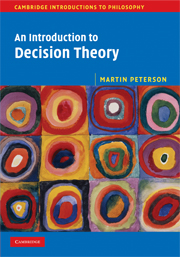Book contents
- Frontmatter
- Contents
- Preface
- 1 Introduction
- 2 The decision matrix
- 3 Decisions under ignorance
- 4 Decisions under risk
- 5 Utility
- 6 The mathematics of probability
- 7 The philosophy of probability
- 8 Why should we accept the preference axioms?
- 9 Causal vs. evidential decision theory
- 10 Bayesian vs. non-Bayesian decision theory
- 11 Game theory I: Basic concepts and zero-sum games
- 12 Game theory II: Nonzero-sum and cooperative games
- 13 Social choice theory
- 14 Overview of descriptive decision theory
- Appendix A Glossary
- Appendix B Proof of the von Neumann–Morgenstern theorem
- Further reading
- Index
2 - The decision matrix
- Frontmatter
- Contents
- Preface
- 1 Introduction
- 2 The decision matrix
- 3 Decisions under ignorance
- 4 Decisions under risk
- 5 Utility
- 6 The mathematics of probability
- 7 The philosophy of probability
- 8 Why should we accept the preference axioms?
- 9 Causal vs. evidential decision theory
- 10 Bayesian vs. non-Bayesian decision theory
- 11 Game theory I: Basic concepts and zero-sum games
- 12 Game theory II: Nonzero-sum and cooperative games
- 13 Social choice theory
- 14 Overview of descriptive decision theory
- Appendix A Glossary
- Appendix B Proof of the von Neumann–Morgenstern theorem
- Further reading
- Index
Summary
Before you make a decision you have somehow to determine what to decide about. Or, to put it differently, you have to specify what the relevant acts, states and outcomes are. Suppose, for instance, that you are thinking about taking out fire insurance on your home. Perhaps it costs $100 to take out insurance on a house worth $100,000, and you ask: Is it worth it? Before you decide, you have to get the formalisation of the decision problem right. In this case, it seems that you face a decision problem with two acts, two states, and four outcomes. It is helpful to visualise this information in a decision matrix; see Table 2.1.
To model one's decision problem in a formal representation is essential in decision theory, since decision rules are only defined relative to such formalisations. For example, it makes no sense to say that the principle of maximising expected value recommends one act rather than another unless there is a formal listing of the available acts, the possible states of the world and the corresponding outcomes. However, instead of visualising information in a decision matrix it is sometimes more convenient to use a decision tree. The decision tree in Figure 2.1 is equivalent to the matrix in Table 2.1.
The square represents a choice node, and the circles represent chance nodes. At the choice node the decision maker decides whether to go up or down in the tree.
- Type
- Chapter
- Information
- An Introduction to Decision Theory , pp. 17 - 39Publisher: Cambridge University PressPrint publication year: 2009

